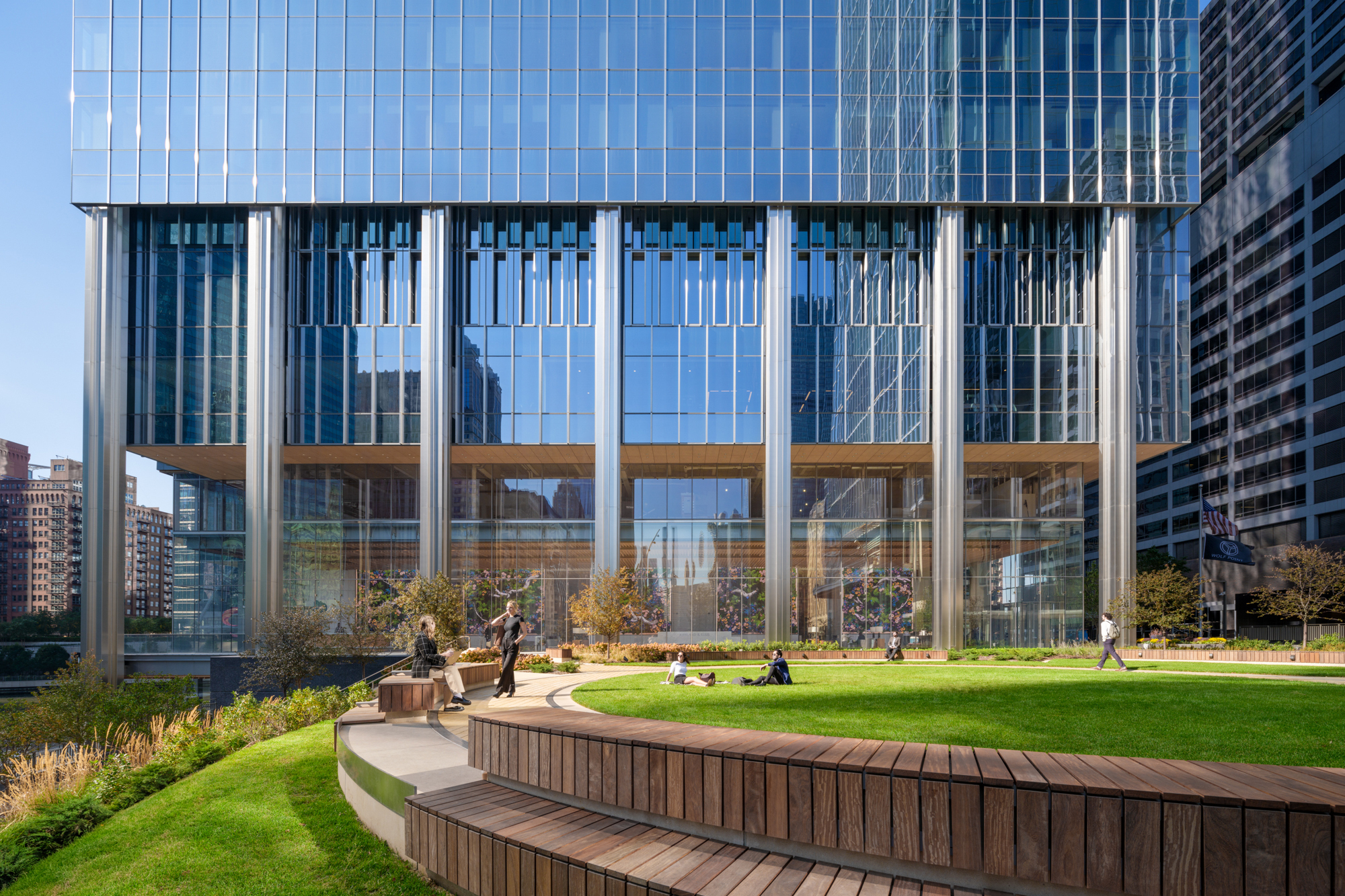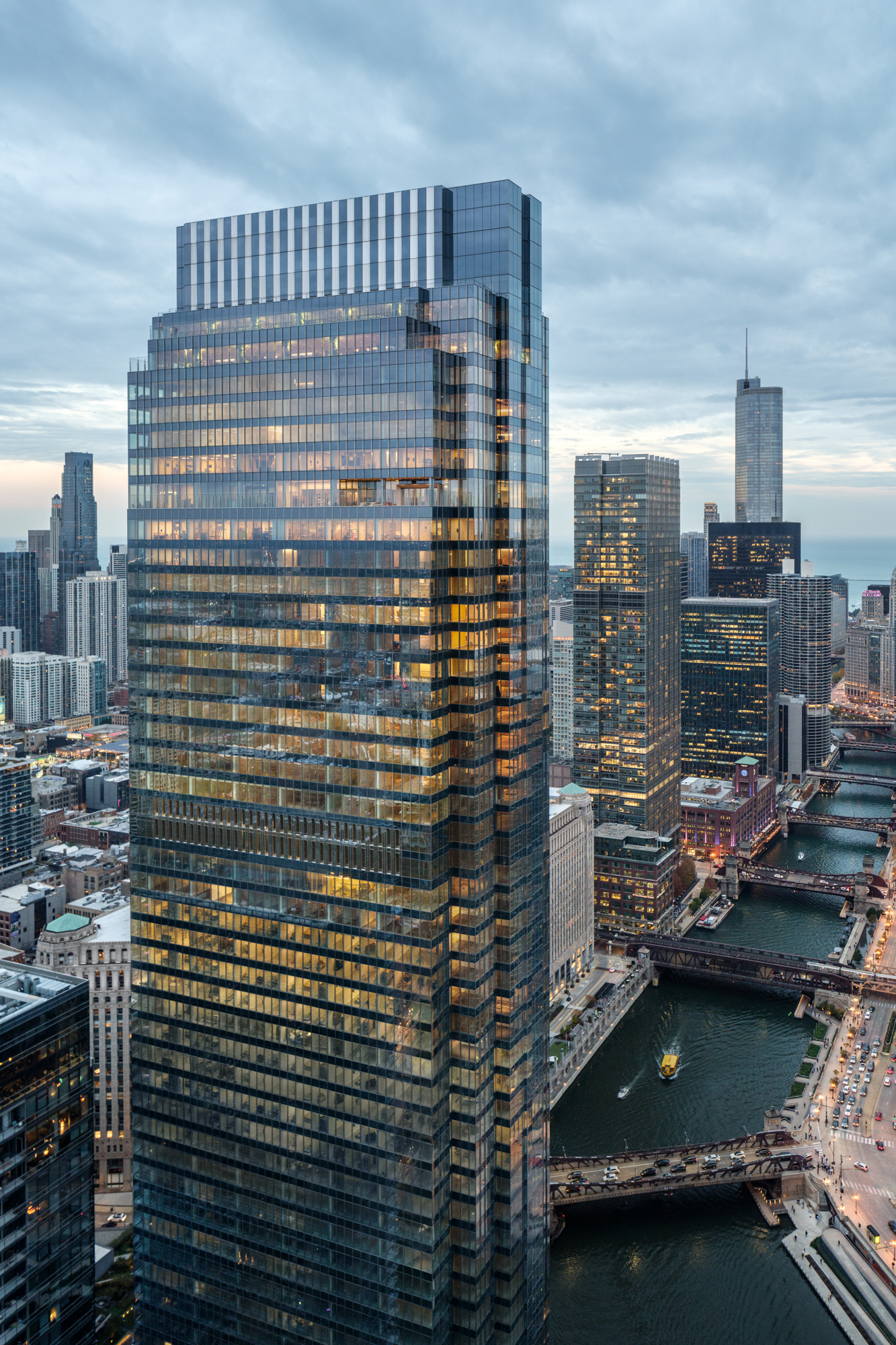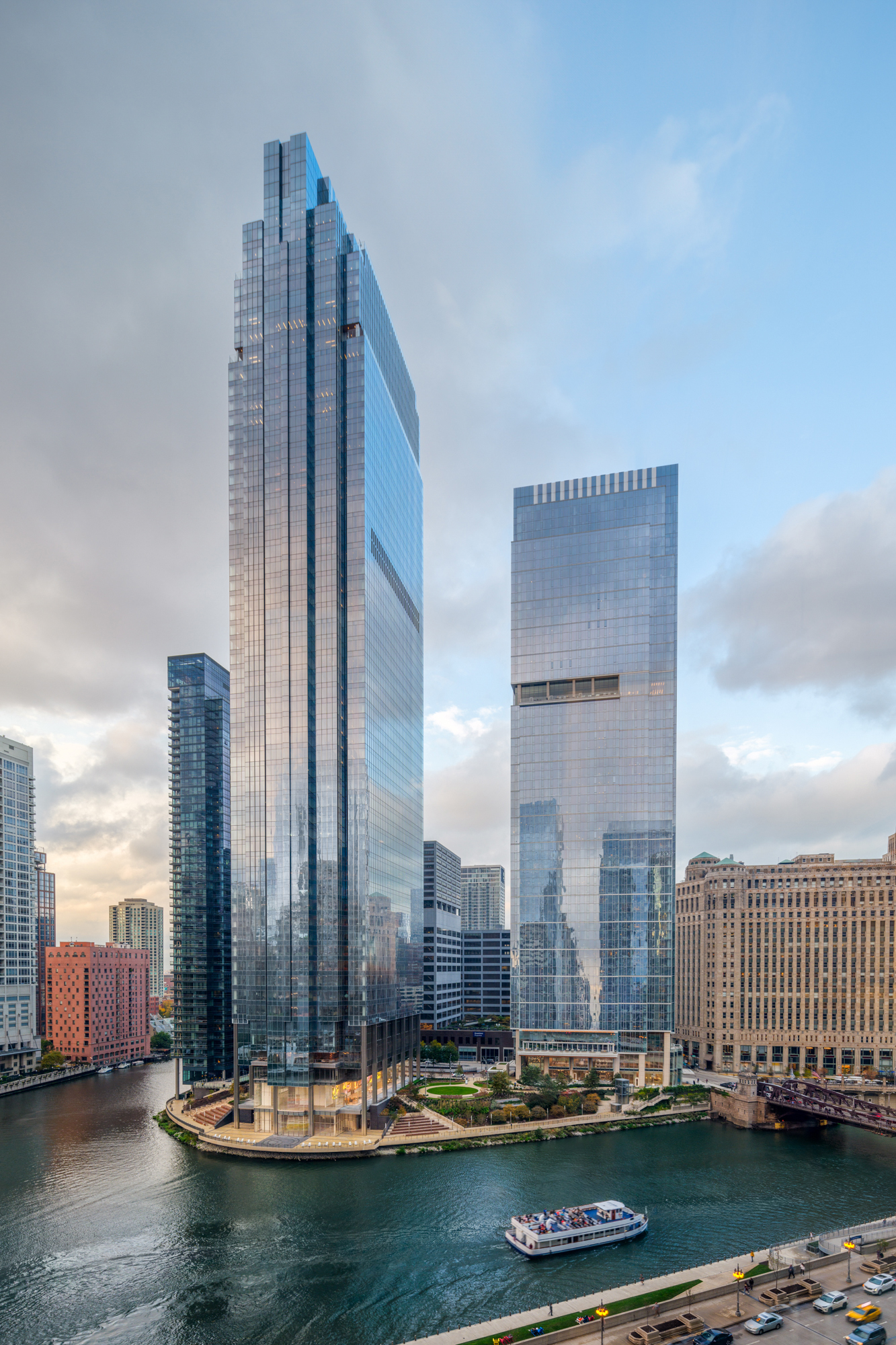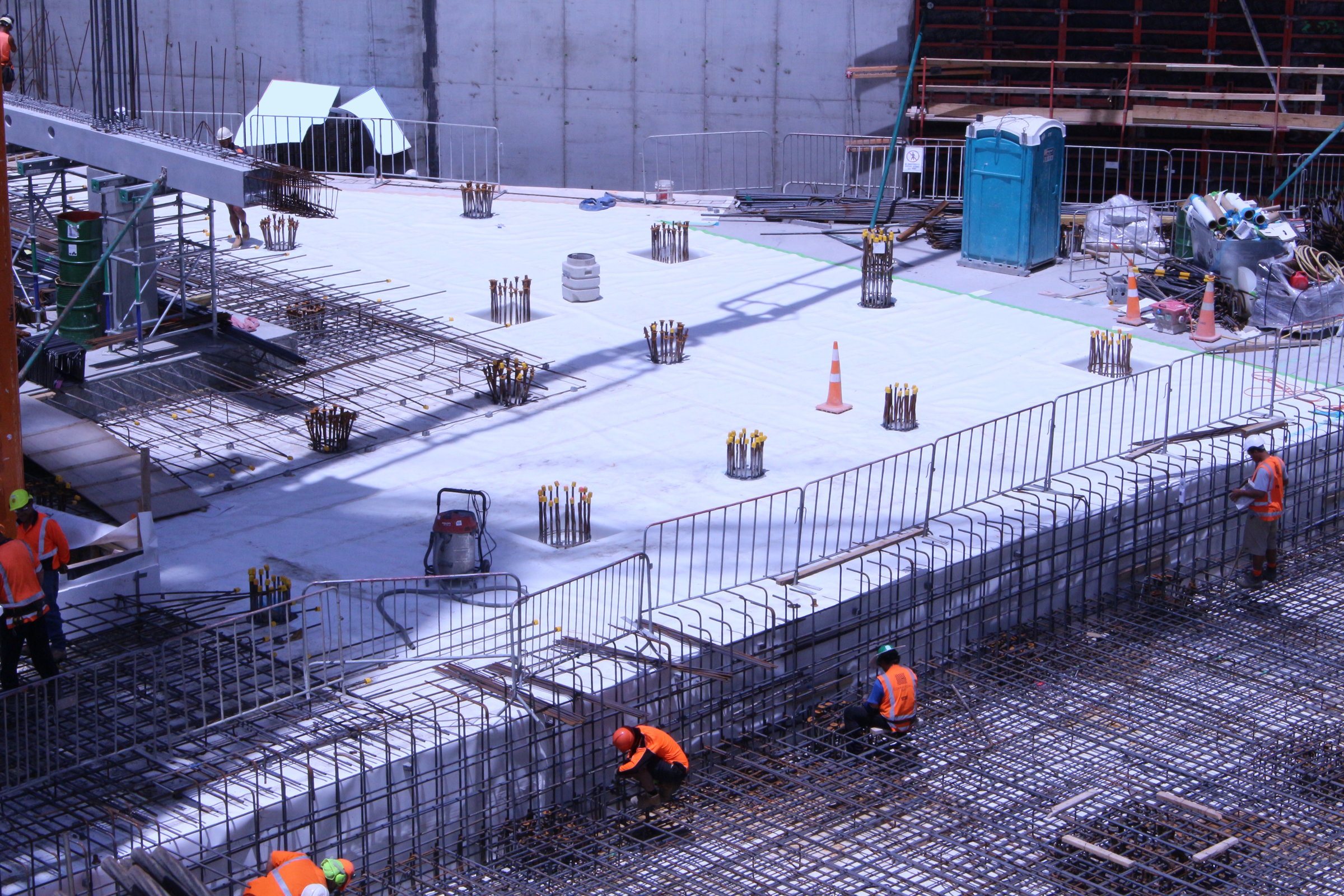Story at a glance:
- Green space, kayaking, and biking are all accessible from the new Salesforce Tower in Chicago.
- The skyscraper design on a very specific site in downtown Chicago promotes density.
- Biophilic-inspired digital artwork is prominent in the building’s interior.
They wanted it to feel like a park. Salesforce Tower Chicago is a modern landmark on a historic site—at the confluence of the Chicago River’s three branches downtown, surrounded by green space with access to the city’s bustling Riverwalk. “It’s really this unique site,” says Darin Cook, partner at Pelli Clarke & Partners and the lead architect for the Chicago Salesforce project.
The new tower anchors Wolf Point, the extraordinary mixed-use development that includes three buildings. Pelli Clarke & Partners started on the project in 2010. “The Salesforce Tower is sort of the crown jewel in the completion of this project,” Cook says. The other two buildings are residential.
With the river and plentiful green space, Cook says this project is not your typical office tower on a city street—and that aligned with the vision of Salesforce, who Pelli Clarke & Partners also worked with for their San Francisco Tower.
It’s very much this physically active, outdoor-focused environment that supports the youthful spirit of Salesforce.
The project was designed to include bike storage and safe entry so employees can come directly in from the Riverwalk or the lower driveway. “People can ride their bikes into the building right into the bike storage below the building,” he says. “It’s very much this physically active, outdoor-focused environment that supports the youthful spirit of Salesforce.” Amenities like a fitness center with showers, coffee bar, conference center and lounge, and underground parking (hidden from sight) are also highlights. There’s even storage for kayaks.
- “This is a skyscraper on a very specific site in downtown Chicago, which promotes density. We feel cities are more sustainable than suburban sprawl,” says Darin Cook, partner at Pelli Clarke & Partners. Photo by Jason O’Rear
- The municipal symbol of Chicago is seen throughout the project. The “y” within a circle represents the three branches of the Chicago River. That’s also the representation of Wolf Point, etched into handrails and in the outdoor space. “That’s really celebrating the intersection of the river, which was essentially the site of the first settlement of Chicago,” Cook says. Photo by Jason O’Rear
“It’s not just a multi-building project. It’s really a mixed-use, live-work-play community,” Cook says. Neighbors can interact while relaxing on the green space or Riverwalk, and the project is a short walk to the Merchandise Mart and multiple modes of public transit. “We have great access to everything on the river. It’s really expanding the local community.”
Many office projects today emphasize outdoor connection, be it through roof terraces or other outdoor spaces on the ground. Salesforce Tower has both, not to mention those river views and access. “People want to get out and have fresh air. They want to get a sense of the seasons, the time of day. They want to exercise,” Cook says. The Salesforce team also wanted a large folding glass wall high on the tower that they could open on nice days to let the breeze in.

Looking out from the top floor of Salesforce Tower Chicago, you feel like you’re sitting in the river. Photo by Jason O’Rear
The entire building is clad with floor-to-ceiling glass. The architects used Viracon [VRE 1-59] insulating glass to reduce the amount of solar energy. “It has a 38% solar energy reflectance, throwing off nearly 40% of the heat that would be cast into the building,” Cook says, with 53% visible light transmittance. “At the same time we’re really trying to spill daylight into the inside of the building, minimizing the amount of electrical lighting we have to provide when it’s nice and sunny. It’s simple, elegant architecture that is still very high-performance.”
The team was also very conscious of where materials came from. Viracon is based in Minnesota, so the glass didn’t have to travel far, and the curtain wall enclosure was fabricated by Harmon, based in Cincinnati. Both locations are within 500 miles of the project site—a critical measure for LEED certification.
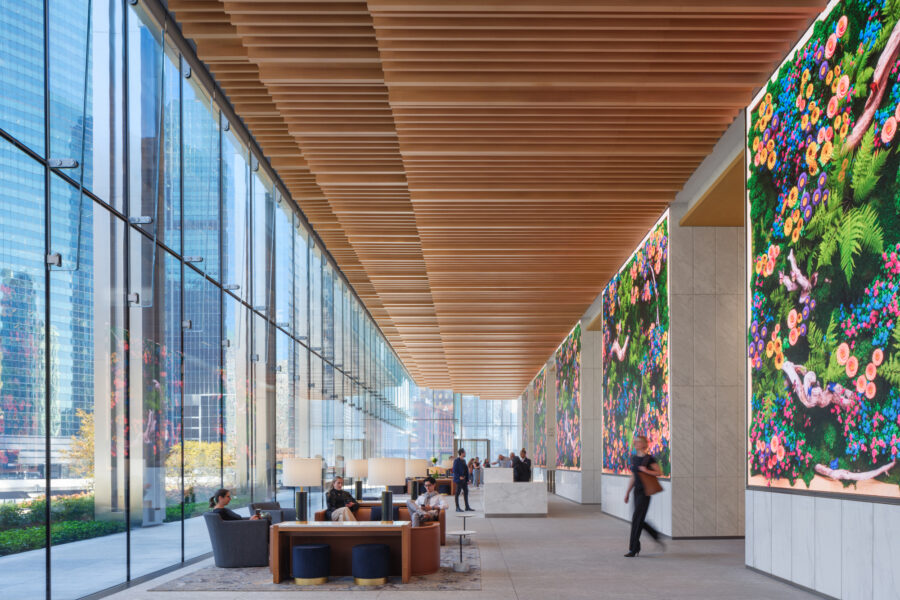
“Our lobby is right up against this outdoor garden park filled with couches and lounge chairs. People come in and they hang out in the lobby. They don’t just rush off to their office space. It’s trying to be a very warm and inviting, living, casual hangout environment. It’s very much part of the spirit of both Salesforce as well as the trends we’re seeing in office development.” Photo by Jason O’Rear
The project also aimed to bring feelings of nature and warmth into the building, with wood details and art. In the lobby a large, rotating art installation cycles through different scenes throughout the day—ranging from a woodland setting from Salesforce’s home base of California to abstract biophilic-inspired digital works, so that feeling of being outside continues.
At the end wall of each elevator lobby are vertical, rolling strips of eucalyptus wood inspired by the river. “It also looks like water rivulets are running through it,” Cook says. Part of that was about bringing in as much wood as possible—not just because that’s what Salesforce wanted, but it’s what many companies want to see in their spaces today. Cook says many of their office tower projects now have lobby spaces that feel like living rooms. “They’re comfortable gathering spaces. They’re not the sort of cold, formal, empty space where you go and check in at a security desk.”
Salesforce Tower Chicago just so happens to be the first building in Chicago to require and measure environmental product declarations, Cook says, so the carbon footprint of materials used across the project was tracked diligently. Many building professionals have moved on from LEED to net zero, Cook says. “Now everyone’s on a path to net zero. How do we get to net zero carbon emissions? To do that you have to start measuring things.”

The municipal symbol of Chicago can be seen throughout the Salesforce project—the “y” within a circle that represents the three branches of the Chicago River where the project sits. “That’s really celebrating the intersection of the river, which was essentially the site of the first settlement of Chicago,” says Darin Cook, partner at Pelli Clarke & Partners and the lead architect for the Chicago Salesforce project. Photo by Jason O’Rear
The project reported a 19% reduction in carbon emissions for concrete and steel production, with a 27% reduction in the production of concrete used and a 9% reduction in the production of steel used, compared to the industry standard. That equates to saving 7,800 tons of CO2, or getting 1,500 cars off the road a year, Cook says.
Beyond the data, though, a truly sustainable building is one that’s used and loved for a long time, Cook says. This project was especially meaningful to him knowing the site’s history. When Daniel Burnham came up with the 1909 “Plan of Chicago,” it included this site as significant, as he envisioned a building icon right where the Salesforce Tower stands today. “We got to build on this long tradition and history of urban planning and growth in Chicago,” Cook says. “It was a fantastic opportunity and honor to bring this vision that’s been floating around for 100-plus years finally to life. We’ve created a great new landmark and icon for the city.”
Project Details
Project: Salesforce Tower
Location: Chicago
Completion: 2023
Size: 1,450,000 square feet
Design Architect: Pelli Clarke & Partners
Architect of Record: HKS Architects
Structural Engineer: Magnusson Klemencic Associates
MEP: Alvine Engineering
Certifications: LEED Gold

